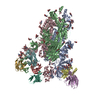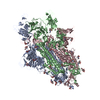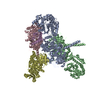[English] 日本語
 Yorodumi
Yorodumi- PDB-7sn3: Structure of human SARS-CoV-2 spike glycoprotein trimer bound by ... -
+ Open data
Open data
- Basic information
Basic information
| Entry | Database: PDB / ID: 7sn3 | ||||||
|---|---|---|---|---|---|---|---|
| Title | Structure of human SARS-CoV-2 spike glycoprotein trimer bound by neutralizing antibody C1C-A3 Fab (variable region) | ||||||
 Components Components |
| ||||||
 Keywords Keywords | VIRAL PROTEIN/IMMUNE SYSTEM / COVID-19 / SARS-CoV-2 / neutralizing antibody / neutralization escape / IMMUNE SYSTEM / VIRAL PROTEIN-IMMUNE SYSTEM complex | ||||||
| Function / homology |  Function and homology information Function and homology informationsymbiont-mediated disruption of host tissue / Maturation of spike protein / Translation of Structural Proteins / Virion Assembly and Release / host cell surface / host extracellular space / viral translation / symbiont-mediated-mediated suppression of host tetherin activity / Induction of Cell-Cell Fusion / structural constituent of virion ...symbiont-mediated disruption of host tissue / Maturation of spike protein / Translation of Structural Proteins / Virion Assembly and Release / host cell surface / host extracellular space / viral translation / symbiont-mediated-mediated suppression of host tetherin activity / Induction of Cell-Cell Fusion / structural constituent of virion / membrane fusion / entry receptor-mediated virion attachment to host cell / Attachment and Entry / host cell endoplasmic reticulum-Golgi intermediate compartment membrane / positive regulation of viral entry into host cell / receptor-mediated virion attachment to host cell / host cell surface receptor binding / symbiont-mediated suppression of host innate immune response / receptor ligand activity / endocytosis involved in viral entry into host cell / fusion of virus membrane with host plasma membrane / fusion of virus membrane with host endosome membrane / viral envelope / symbiont entry into host cell / virion attachment to host cell / SARS-CoV-2 activates/modulates innate and adaptive immune responses / host cell plasma membrane / virion membrane / identical protein binding / membrane / plasma membrane Similarity search - Function | ||||||
| Biological species |   Homo sapiens (human) Homo sapiens (human) | ||||||
| Method | ELECTRON MICROSCOPY / single particle reconstruction / cryo EM / Resolution: 3.1 Å | ||||||
 Authors Authors | Pan, J. / Abraham, J. / Shankar, S. | ||||||
| Funding support |  United States, 1items United States, 1items
| ||||||
 Citation Citation |  Journal: Science / Year: 2022 Journal: Science / Year: 2022Title: Structural basis for continued antibody evasion by the SARS-CoV-2 receptor binding domain. Authors: Katherine G Nabel / Sarah A Clark / Sundaresh Shankar / Junhua Pan / Lars E Clark / Pan Yang / Adrian Coscia / Lindsay G A McKay / Haley H Varnum / Vesna Brusic / Nicole V Tolan / Guohai ...Authors: Katherine G Nabel / Sarah A Clark / Sundaresh Shankar / Junhua Pan / Lars E Clark / Pan Yang / Adrian Coscia / Lindsay G A McKay / Haley H Varnum / Vesna Brusic / Nicole V Tolan / Guohai Zhou / Michaël Desjardins / Sarah E Turbett / Sanjat Kanjilal / Amy C Sherman / Anand Dighe / Regina C LaRocque / Edward T Ryan / Casey Tylek / Joel F Cohen-Solal / Anhdao T Darcy / Davide Tavella / Anca Clabbers / Yao Fan / Anthony Griffiths / Ivan R Correia / Jane Seagal / Lindsey R Baden / Richelle C Charles / Jonathan Abraham /   Abstract: Many studies have examined the impact of severe acute respiratory syndrome coronavirus 2 (SARS-CoV-2) variants on neutralizing antibody activity after they have become dominant strains. Here, we ...Many studies have examined the impact of severe acute respiratory syndrome coronavirus 2 (SARS-CoV-2) variants on neutralizing antibody activity after they have become dominant strains. Here, we evaluate the consequences of further viral evolution. We demonstrate mechanisms through which the SARS-CoV-2 receptor binding domain (RBD) can tolerate large numbers of simultaneous antibody escape mutations and show that pseudotypes containing up to seven mutations, as opposed to the one to three found in previously studied variants of concern, are more resistant to neutralization by therapeutic antibodies and serum from vaccine recipients. We identify an antibody that binds the RBD core to neutralize pseudotypes for all tested variants but show that the RBD can acquire an N-linked glycan to escape neutralization. Our findings portend continued emergence of escape variants as SARS-CoV-2 adapts to humans. | ||||||
| History |
|
- Structure visualization
Structure visualization
| Movie |
 Movie viewer Movie viewer |
|---|---|
| Structure viewer | Molecule:  Molmil Molmil Jmol/JSmol Jmol/JSmol |
- Downloads & links
Downloads & links
- Download
Download
| PDBx/mmCIF format |  7sn3.cif.gz 7sn3.cif.gz | 643.6 KB | Display |  PDBx/mmCIF format PDBx/mmCIF format |
|---|---|---|---|---|
| PDB format |  pdb7sn3.ent.gz pdb7sn3.ent.gz | 511.8 KB | Display |  PDB format PDB format |
| PDBx/mmJSON format |  7sn3.json.gz 7sn3.json.gz | Tree view |  PDBx/mmJSON format PDBx/mmJSON format | |
| Others |  Other downloads Other downloads |
-Validation report
| Summary document |  7sn3_validation.pdf.gz 7sn3_validation.pdf.gz | 1.2 MB | Display |  wwPDB validaton report wwPDB validaton report |
|---|---|---|---|---|
| Full document |  7sn3_full_validation.pdf.gz 7sn3_full_validation.pdf.gz | 1.3 MB | Display | |
| Data in XML |  7sn3_validation.xml.gz 7sn3_validation.xml.gz | 96.1 KB | Display | |
| Data in CIF |  7sn3_validation.cif.gz 7sn3_validation.cif.gz | 149 KB | Display | |
| Arichive directory |  https://data.pdbj.org/pub/pdb/validation_reports/sn/7sn3 https://data.pdbj.org/pub/pdb/validation_reports/sn/7sn3 ftp://data.pdbj.org/pub/pdb/validation_reports/sn/7sn3 ftp://data.pdbj.org/pub/pdb/validation_reports/sn/7sn3 | HTTPS FTP |
-Related structure data
| Related structure data |  25210MC  7sn0C  7sn1C  7sn2C M: map data used to model this data C: citing same article ( |
|---|---|
| Similar structure data |
- Links
Links
- Assembly
Assembly
| Deposited unit | 
|
|---|---|
| 1 |
|
- Components
Components
| #1: Protein | Mass: 141192.203 Da / Num. of mol.: 3 Mutation: R682G, R683S, R685S, F817P, A892P, A899P, A942P, K986P, V987P Source method: isolated from a genetically manipulated source Details: isolation Wuhan-Hu-1 Source: (gene. exp.)  Gene: S, 2 / Variant: Wuhan-Hu-1 / Plasmid: pHLSec Cell line (production host): HEK-293 (Thermo Fisher Expi293F) Production host:  Homo sapiens (human) / References: UniProt: P0DTC2 Homo sapiens (human) / References: UniProt: P0DTC2#2: Antibody | Mass: 27022.607 Da / Num. of mol.: 3 Source method: isolated from a genetically manipulated source Details: mature antibody (after somatic hypermutation) from germline gene IGHV3-33 Source: (gene. exp.)  Homo sapiens (human) / Gene: IGHV3-33 / Plasmid: pVRC8400 Homo sapiens (human) / Gene: IGHV3-33 / Plasmid: pVRC8400Cell line (production host): HEK-293 (Thermo Fisher Expi293F) Production host:  Homo sapiens (human) Homo sapiens (human)#3: Antibody | Mass: 25896.107 Da / Num. of mol.: 3 Source method: isolated from a genetically manipulated source Details: mature antibody (after somatic hypermutation) from germline gene IGKV3-11 Source: (gene. exp.)  Homo sapiens (human) / Gene: IGKV3-11 / Plasmid: pVRC8400 Homo sapiens (human) / Gene: IGKV3-11 / Plasmid: pVRC8400Cell line (production host): HEK-293T (Thermo Fisher Expi293F) Production host:  Homo sapiens (human) Homo sapiens (human)#4: Polysaccharide | Source method: isolated from a genetically manipulated source #5: Sugar | ChemComp-NAG / Has ligand of interest | N | Has protein modification | Y | |
|---|
-Experimental details
-Experiment
| Experiment | Method: ELECTRON MICROSCOPY |
|---|---|
| EM experiment | Aggregation state: PARTICLE / 3D reconstruction method: single particle reconstruction |
- Sample preparation
Sample preparation
| Component |
| ||||||||||||||||||||||||||||
|---|---|---|---|---|---|---|---|---|---|---|---|---|---|---|---|---|---|---|---|---|---|---|---|---|---|---|---|---|---|
| Molecular weight |
| ||||||||||||||||||||||||||||
| Source (natural) |
| ||||||||||||||||||||||||||||
| Source (recombinant) |
| ||||||||||||||||||||||||||||
| Buffer solution | pH: 7.5 | ||||||||||||||||||||||||||||
| Buffer component |
| ||||||||||||||||||||||||||||
| Specimen | Conc.: 0.9 mg/ml / Embedding applied: NO / Shadowing applied: NO / Staining applied: NO / Vitrification applied: YES | ||||||||||||||||||||||||||||
| Specimen support | Details: glow discharge done at 20 mA in Pelco easiGlow / Grid material: COPPER / Grid mesh size: 300 divisions/in. / Grid type: Quantifoil R1.2/1.3 | ||||||||||||||||||||||||||||
| Vitrification | Instrument: FEI VITROBOT MARK IV / Cryogen name: ETHANE / Humidity: 100 % / Chamber temperature: 293 K / Details: blotting time 4-6 seconds |
- Electron microscopy imaging
Electron microscopy imaging
| Experimental equipment |  Model: Titan Krios / Image courtesy: FEI Company |
|---|---|
| Microscopy | Model: FEI TITAN KRIOS / Details: Cs-corrected, energy filtered |
| Electron gun | Electron source:  FIELD EMISSION GUN / Accelerating voltage: 300 kV / Illumination mode: FLOOD BEAM FIELD EMISSION GUN / Accelerating voltage: 300 kV / Illumination mode: FLOOD BEAM |
| Electron lens | Mode: BRIGHT FIELD / Nominal magnification: 105000 X / Calibrated magnification: 60606 X / Nominal defocus max: 2500 nm / Nominal defocus min: 1000 nm / Cs: 2.7 mm / C2 aperture diameter: 50 µm / Alignment procedure: COMA FREE |
| Specimen holder | Cryogen: NITROGEN / Specimen holder model: FEI TITAN KRIOS AUTOGRID HOLDER / Temperature (max): 77 K / Temperature (min): 77 K |
| Image recording | Average exposure time: 0.038 sec. / Electron dose: 56.6 e/Å2 / Film or detector model: GATAN K3 BIOQUANTUM (6k x 4k) / Num. of grids imaged: 1 / Num. of real images: 4583 |
| Image scans | Sampling size: 5 µm / Width: 5760 / Height: 4092 |
- Processing
Processing
| Software | Name: PHENIX / Version: 1.19_4080: / Classification: refinement | ||||||||||||||||||||||||||||||||||||||||
|---|---|---|---|---|---|---|---|---|---|---|---|---|---|---|---|---|---|---|---|---|---|---|---|---|---|---|---|---|---|---|---|---|---|---|---|---|---|---|---|---|---|
| EM software |
| ||||||||||||||||||||||||||||||||||||||||
| CTF correction | Type: NONE | ||||||||||||||||||||||||||||||||||||||||
| Particle selection | Num. of particles selected: 1296929 | ||||||||||||||||||||||||||||||||||||||||
| Symmetry | Point symmetry: C1 (asymmetric) | ||||||||||||||||||||||||||||||||||||||||
| 3D reconstruction | Resolution: 3.1 Å / Resolution method: FSC 0.143 CUT-OFF / Num. of particles: 344920 / Algorithm: FOURIER SPACE / Num. of class averages: 2 / Symmetry type: POINT | ||||||||||||||||||||||||||||||||||||||||
| Atomic model building | B value: 77.28 / Protocol: OTHER / Space: REAL / Target criteria: correlation coefficient | ||||||||||||||||||||||||||||||||||||||||
| Refine LS restraints |
|
 Movie
Movie Controller
Controller











 PDBj
PDBj







